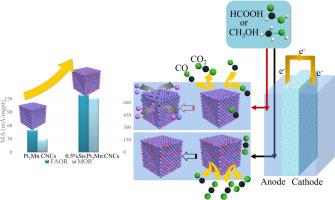Journal of Catalysis ( IF 7.3 ) Pub Date : 2021-01-05 , DOI: 10.1016/j.jcat.2020.12.034 Yunrui Li , Yao Wang , Shuna Li , Mingxuan Li , Yujie Liu , Xu Fang , Xiaoping Dai , Xin Zhang

|
Modulating the surface structure of Pt-based alloy by oxyphilic component has been proven significantly enhancement of activity and stability for electro-oxidation of small organic molecules. Inspired by these advances, the oxyphilic metal Sn is implanted into the surface of Pt3Mn concave nanocubes (CNCs) to explore the promoting effect of foreign component on stepped Pt based alloy surface in this work. Detailed characterizations of catalysts reveal that the significant surface alloying layers (Pt-Mn-Sn) are formed after the insertion of Sn. The obtained Sn/Pt3Mn catalysts present the better specific activity (SA) and mass activity (MA) compared to the unmodified Pt3Mn catalyst towards both the electro-oxidation of formic acid (FAOR) and methanol (MOR). The optimal 0.5%Sn/Pt3Mn exhibits the enhanced mass activity of 4.07 and 2.60 folds than the Pt3Mn CNCs for MOR and FAOR, respectively. In particular, the optimal 0.5%Sn/Pt3Mn catalyst performs the efficient boost of stability and CO tolerance ability due to the stabilized effect on surface structure by Sn. Further investigations indicate that the presence of oxyphilic metal Sn can efficiently protect the surface structure from disruption. The thermodynamics studies also suggest that the Sn-doped catalysts have the advantage in decreasing the reaction activation energy than that of uncorporated Sn. All results demonstrate that the doped-Sn oxyphilic metals on the surface of Pt3Mn CNCs with high-index facets (HIFs) gives the better catalytic performance for electrooxidation of small organic molecules, further providing the design strategy for the protection of HIFs.
中文翻译:

Sn掺杂修饰的高折射率小平面Pt 3 Mn合金纳米结构,用于高催化活性电氧化反应
已证明通过亲氧组分调节Pt基合金的表面结构可以显着增强小有机分子的电氧化活性和稳定性。受这些进展的启发,将富氧金属Sn植入到Pt 3 Mn凹形纳米立方体(CNC)的表面中,以探索异物对阶梯式Pt基合金表面的促进作用。催化剂的详细表征表明,在插入Sn后形成了重要的表面合金层(Pt-Mn-Sn)。与未改性的Pt 3相比,所获得的Sn / Pt 3 Mn催化剂具有更好的比活度(SA)和质量活度(MA)。锰催化剂可同时对甲酸(FAOR)和甲醇(MOR)进行电氧化。最佳的0.5%Sn / Pt 3 Mn的质量活性比MOR和FAOR的Pt 3 Mn CNC分别高4.07倍和2.60倍。特别是最佳的0.5%Sn / Pt 3Mn催化剂由于Sn对表面结构的稳定作用而有效地提高了稳定性和CO耐受性。进一步的研究表明,亲金属Sn的存在可以有效地保护表面结构免受破坏。热力学研究还表明,与未结合的Sn相比,Sn掺杂的催化剂在降低反应活化能方面具有优势。所有结果表明,具有高折射率小面(HIF)的Pt 3 Mn CNCs表面掺杂的Sn嗜氧金属为小的有机分子的电氧化提供了更好的催化性能,进一步为保护HIF提供了设计策略。



























 京公网安备 11010802027423号
京公网安备 11010802027423号